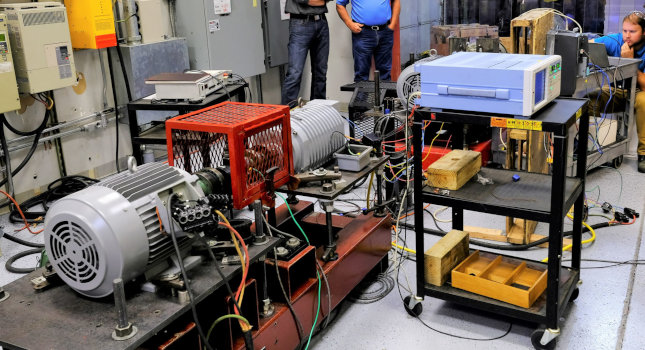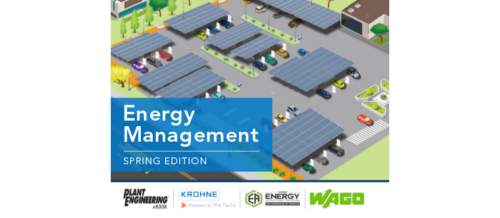Energy management with variable speed drives, Part 2
Scott Sullivan discusses energy savings with VFDs and offers advice on how to achieve energy savings and methods to improve energy efficiency.
Energy management insights
- By using drives to control the speed of motors in air handling and other applications, it is possible to run the motor at the necessary speed, rather than at a constant full speed, leading to significant energy savings.
- The use of drives has been common in industry for many years, but has only become popular in HVAC systems since the 1990s. Older methods of controlling motor speed, such as magnetic clutches, are highly inefficient by comparison.
Variable frequency drives (VFDs) provide effective speed control of ac motors by manipulating voltage and frequency. Controlling the speed of a motor provides users with improved process control, reduced wear on machines, increased power factor and large energy savings. The most significant energy savings can be achieved in applications with a variable torque load. Reducing a fan speed in a variable torque load application by 20% can achieve energy savings of 50%. For most motion control applications, reducing motor speed is often the easiest way to achieve large energy savings.
Scott Sullivan, a field service engineer at Electronic Drives and Controls (EDC), a certified system CSIA system integrator, gave a presentation on Energy Management with Variable Frequency Drives with CFE. Sullivan specializes in the application of variable frequency drive technology and onsite field service of ac drives. Since joining EDC in 2016, Sullivan has served on EDC’s field service support team performing repairs, preventative maintenance services, startups, training, and much more for ac and dc drives, PLCs and factory automation. Sullivan is a graduate of the University of Rhode Island with a bachelor’s degree in electrical and electronics engineering.
The presentation has been edited for clarity.
Achieving energy savings with drives
Moving on to energy savings with drives, you may be wondering, “Great, Scott, we changed the frequency, we changed the speed, what difference does it make?”
Changing the speed of the motor is a lot more useful than you’d think. The way things were done in the past is that motors were run at full speed. You plug a motor into the wall, it runs at whatever frequency you’re getting from the power utility or power company. In the United States, it comes in at 60 Hz, and in other parts of the world it came in at 50 Hz, but when you’re plugged in and running, that’s as fast as this motor’s going. You can’t go any faster or slower. But because of this, for a long time, people just let motors run at full speed, and they used alternate ways to control how. What they were actually trying to do was slow it down.
This is an example that I still see a lot. This is an older way to control airflow primarily in buildings. So, what would happen is, if you look at the top, there are fans going 100%, but we only need like 10% airflow. So, what they did was let this fan go, spin wild as much as it wanted and only opened the dampers 10%. Because of that, only 10% of the air gets out to the building and that’s how you get your 10%. The second example, fans are going at 100%, but their dampers are open 50%. Because of this, the fan’s going 100% and you’re only getting 50% airflow.
The last example is the fan still going at 100%, but now you have the dampers open 100%, so now you have 100% airflow. This works. This limits the airflow as much as you possibly need, but especially in the first two examples, if you only need 10% or 50%, why are you spinning this motor at full speed? It doesn’t make any sense. Needless to say, it’s highly inefficient. The more modern way to do this, and this is really one of the primary uses you see drives, air handlers and various air moving applications in buildings, is the dampers are fully opened or fully closed. The dampers basically act as an on-off switch.
You fully open these dampers and kick on the drive. The drive will let you run the motor at whatever speed you want. You go 10%, leave the dampers open 100%, so when it’s on, you only spend the motor 10%. When you beed to go 50% dampers full on open, you only spend the motor 50%. If you need it at 100%, you’re going to be looking more or less like we did in the previous example. The dampers are open 100%, motors going at 100%, At 100% speed, there isn’t a dramatic difference. Drives help you because they allow you to slow down to only meet the demand that you need. This would be highly efficient if you do it this way.
If you can get away with spinning your motor lower than maximum speed, you will save on energy always. So, for example in an industrial setting, industry has long since adopted drives because I think in HVAC, it’s only since the ’90s that drives have really been in use, but drives have been around in industry far longer, at least as far back as the ’70s. They weren’t modern drives, but they were precursory drives.
Methods to improve drive energy efficiency
There’s still some examples floating around. I was trying to think of an example, and the best I could really come up with was what’s known as a clutch, an eddy current clutch specifically.
They’re highly inefficient. But back in the ’70s when they were from, they didn’t really care about energy efficiency. So, in this example, an ac motor is just spinning 100%. You plug it in, it’s spinning at 60 Hz or 50 Hz, wherever in the world you have it to be located. And what happens is you use a magnetic clutch to engage the shaft. If you engage the shaft 50%, the output side of the shaft spins 50%. If you engage it 100%, it’s 100%. If you engage it 10%, it’s 10%. It works, you get the speed on the clutch side of the shaft at whatever speed you need, but that ac motor is still spinning at 100%.
You could probably guess the more energy efficient way to do this, you take the clutch out of the system and you just spin an ac motor on a drive. The drive will allow you to spin it at 10% if you need to run the machine at 10%, 50% if you need to run at 50% or even as high as 100% if you need to. I was struggling with this example because it’s not very common. I still do see them in my line of work as a field service tech, but they’re very much so dropped in popularity. However, one of our manufacturers came in for a visit and said a certain empire state, their department of public works, had just ordered four of these, brand new, and I think somewhere in the neighborhood of 1,000 HP, so they still get used.
You look at the right of this graph, this is going to represent 100% flow, speed, CFM, whatever you’re measuring. This is an example where you’re moving 100% of material, the power’s going out at 100%. The other thing to look at is zero, on the left side of this graph. This is an example of dampers being totally closed and that clutch being totally disengaged. If you’re moving water, it could be a pump with the valves closed. At any rate, this thing’s not moving any product at all, and the motor’s still going 100%.
So, when you’re not moving any product, if you look at the graph, you’re still using about 60% of the power. So, this is a graph showing the side-by-side comparison. A drive at 100%, you’re still using 100% power, really can’t get around that. But as you can see, as you slow it down, you start dramatically using less power. I think we have it going as low as 30%, and at that point you’re only using 10% power. Your energy savings is going to be the difference between these two. At any given flow rate, the difference between a motor running full speed and a motor running a drive is how much you’re going to save.
I have a breakdown here for you. If you look at the graph, at 90%, which is on the bottom, you track it over to the left, our graph says 95%, 85% power. So, your power assumption would be 85%. So, if you can just slow this thing down by 5%, you’re saving 15% of your power savings. If you can slow it down even more by 10%, which is 90% speed, it’s down to 73% power consumption, that’s a 27% decrease. If you can go for broke and go 80% speed, it’s 20% reduction, you’re down to a 51% power consumption, that’s unbelievable.
I’ve had customers where I install a drive, and they just have me set a global maximum on speed and they say, “Scott, don’t make this thing ever go faster than 95%, if I call for 100%, don’t care, only make it go 95%.”
They’re that concerned about the energy savings, and they’re that concerned about how much money they can save. So, the percentages tell the story for me. I did, however, have our sales people put together a bunch of numbers. This is going to be based on running 80 hours a week.in a factory, this will be running five days a week, two shifts, if it’s in a building, maybe run 12 hours a day during the week and 10 hours a day on the weekends.
So, 80 hours a week, it’s going to be based on an operating expense of 11 cents a kWh. Your mileage will vary, if you’re in a part of the country or the world where you spend more per kilowatt-hour, you’re going to save more. If you get charged less, you’re going to save a little less too. So, an important thing is that VFD and motor energy efficiency is included.
So, if you look at this, at 11 cents a kWh and 80 hours of run time, you’re going to save over $4,000 annually by running this thing just 5% lower. So, if you have a drive that only costs $4,000 in a year, it pays for itself. You can drop this even less, same run time, same kilowatt-hour consumption, jump this up to over $9,000.
Now, at 80% where you’re saving so much it’s almost half, it gets to astronomical numbers. So, at this point, I don’t know how else I can explain it to you, the energy savings are to a point where the drive can almost pay for itself and in very short order.
Do you have experience and expertise with the topics mentioned in this content? You should consider contributing to our CFE Media editorial team and getting the recognition you and your company deserve. Click here to start this process.



